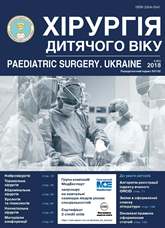Mini-invasive treatment in solitary nonparasitic parenchymal organs in children
DOI:
https://doi.org/10.15574/PS.2018.61.74Keywords:
not parasitic cysts of parenchymal organs, puncture sclerosing treatment, childrenAbstract
The purpose of the study is to investigate the clinical efficacy of puncture sclerosing treatment in solitary nonparasitic parenchymal organs (PO) cysts (kidneys, spleen, liver) in children.
Materials and methods. The basis of the work is the results of examination and treatment of 72 children with PO simple cysts from the age of 1 month to 17 years. Among them, the most numerous group (53 patients, 73.6%) were patients with cysts of the kidneys, 13 patients (18.1%) had spleen cysts, in 6 children (8.3%) were non parasitic liver cysts. 22 children underwent treatment with percutaneous puncture / catheterization of cysts with sclerosing by 96º ethyl alcohol, cooled down to -20º C under ultrasonographic navigation (14 patients with kidney cysts, 6 children with cysts of the spleen and 2 children with liver cysts).
Results. Evaluation of treatment results was performed immediately after treatment, after 6 months and 1 year. We did not receive any unsatisfactory results. A satisfactory result was obtained in 14 children (63.6%), among them 8 patients with cysts of the kidneys, 4 – with cysts of the spleen, 2 – with cysts of the liver. A good result of treatment was noted in 8 (36.4%) children (6 – kidney cysts, 2 – spleen cysts). We noted the best treatment effect in simple cysts with a diameter of 5-7 cm. We did not observe relapse of cysts or serious complications (bleeding, suppurations, peritonitis) with the use of puncture sclerosing treatment. When difficult localization of the splenic cyst, the laparoscopic assistance is effective. Important in achieving a positive effect in the puncture sclerosing treatment of PO simple cysts is to ensure necrosis of the epithelial lining of the cyst without damaging the surrounding tissues.
References
Belyaeva AV, Polyaev AY, Rozinov VM. (2016). Nonparasitic cysts of the spleen in children (etiology, classification, organ-preserving treatment). Rus. messenger of ped. surgery, anesthesiology, resuscitation. 6(3): 102–9.
Vrublevskaya EN, Kovarsky SL, Vrublevsky SG, Feoktistova EV, Gurevich AI, Poddubny GS. (2010). Modern ideas about the etiopathogenesis, clinic, diagnosis and treatment of solitary cyst of the kidney in children. Pediatric surgery. 2: 39–42.
Polyaev YuA, Isaeva MV, Stepanov AE, Fokin NV, Ashmanov KY, Myzin AV, Garbuzov RV, Karimov IV. (2009). Minimally invasive treatment of non-parasitic spleen cysts in children. Pediatric surgery. 3: 13–16.
Hodge MG, Ricketts RR, Simoneaux SF, Abramowsky CR. (2012). Splenic Cysts in the Pediatric Population: A Report of 21 Cases with Review of the Literature. Fetal and pediatric pathology. 31(2): 54–62. https://doi.org/10.3109/15513815.2011.648725; PMid:22409406
Kawamura J., Hiura M., Ueda M., Higashi Y., Yoshida O., Kuwahara C, Ueda M. (1984). Ultrasound splenic cyst puncture and 95% ethanol injection. Ann. Surg. 30(3): 287–94.
Koh С, CserniТ, Hawkes R, Dickson AP, Hennayake S, Keene DJB. (2018). The management of symptomatic simple renal cysts in children. Journal of Pediatric Surgery Case Reports. 28: 21–29.
Koutlidis N, Joyeux L, Mejean N, Sapin E. (2015). Management of simple renal cyst in children: French multicenter experience of 36 cases and review of the literature. J Pediatr Urol. 11(3): 113–7. https://doi.org/10.1016/j.jpurol.2015.03.003; PMid:25934353
Moir С, Guttmann F, Jerquer S et al. (1989). Splenic cysts: aspiration, sclerosis or resection. J Pediatric Surg. 24(7): 646–8.
Morandi E., Castoldi M., Merlini D.A. et al. (2012). Is there a role of percutaneous drainage in non-parasitic splenic cysts? Case report. Journal of Surgery. 33(10): 343–5.
Pegios A, Chaidos C, Klokkaris A, Tsikopoulos G. (2014). Nonparasitic cysts in children – peculiarities in surgical management – report of three cases. Hellenic Journal of Surgery. 86(4): 238–43. https://doi.org/10.1007/s13126-014-0138-5
Downloads
Issue
Section
License
The policy of the Journal “PAEDIATRIC SURGERY. UKRAINE” is compatible with the vast majority of funders' of open access and self-archiving policies. The journal provides immediate open access route being convinced that everyone – not only scientists - can benefit from research results, and publishes articles exclusively under open access distribution, with a Creative Commons Attribution-Noncommercial 4.0 international license(СС BY-NC).
Authors transfer the copyright to the Journal “PAEDIATRIC SURGERY.UKRAINE” when the manuscript is accepted for publication. Authors declare that this manuscript has not been published nor is under simultaneous consideration for publication elsewhere. After publication, the articles become freely available on-line to the public.
Readers have the right to use, distribute, and reproduce articles in any medium, provided the articles and the journal are properly cited.
The use of published materials for commercial purposes is strongly prohibited.

